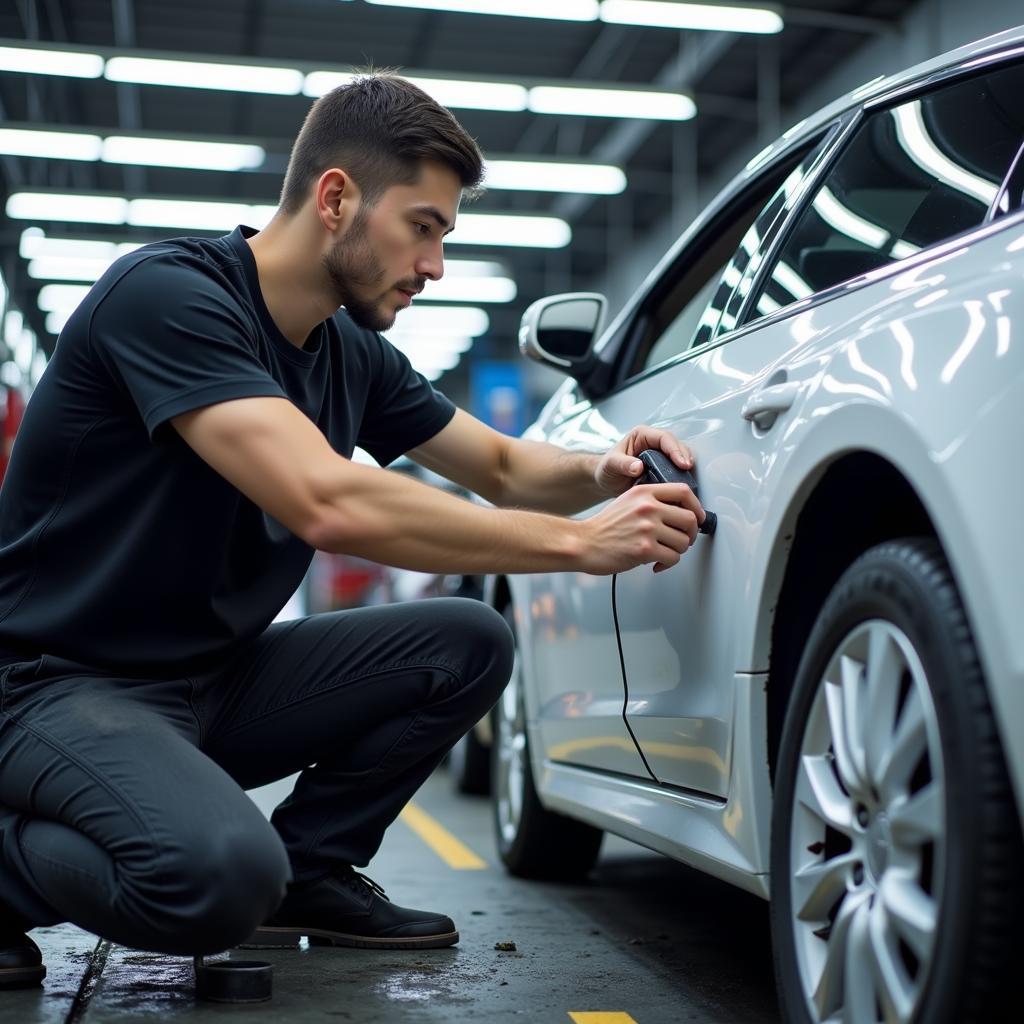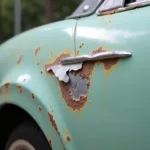Car paint crack repair is a common issue faced by car owners. From minor hairline cracks to larger, more noticeable damage, these imperfections can detract from your car’s appearance and even affect its resale value. Understanding the causes, prevention, and repair options is essential to maintaining your vehicle’s aesthetics and protecting it from further damage. Let’s explore everything you need to know about car paint crack repair. For DIY enthusiasts, check out our guide on diy car paint crack repair.
Understanding Car Paint Cracks: Causes and Types
Cracks in car paint can stem from various factors, ranging from environmental stress to improper car care practices. Knowing the root cause can help you prevent future cracks and choose the most effective repair method. Common culprits include:
- UV Damage: Prolonged exposure to the sun’s harmful UV rays can cause the paint to dry out, become brittle, and eventually crack. This is especially prevalent in hotter climates.
- Temperature Fluctuations: Rapid changes in temperature can cause the paint to expand and contract, leading to stress cracks, particularly in regions with extreme weather variations.
- Improper Washing and Waxing: Using harsh chemicals or abrasive materials during washing and waxing can wear down the paint’s protective layer, making it susceptible to cracking.
- Impact Damage: Stones, road debris, and minor collisions can chip or crack the paint, creating an entry point for moisture and further damage.
- Poor Paint Application: In some cases, cracks can be attributed to improper paint application during manufacturing or repainting, such as using incorrect paint mixtures or failing to properly prepare the surface.
Different types of cracks require different repair approaches. Hairline cracks, also known as spider cracks, are thin, web-like cracks often caused by UV damage. Stress cracks, on the other hand, are typically longer and deeper, resulting from impact or temperature fluctuations. Clear coat cracks affect only the top layer of clear coat, while base coat cracks penetrate deeper, exposing the underlying primer. Learn more about repairing cracked car paint at how to repair cracked car paint.
DIY vs. Professional Car Paint Crack Repair
Minor hairline cracks can sometimes be addressed with DIY solutions, offering a cost-effective approach. However, more extensive damage, such as deep stress cracks or base coat cracks, often requires the expertise of a professional auto body shop. Find out how to repair paint cracks on your car here: how to repair paint cracks on car.
DIY Car Paint Crack Repair: A Step-by-Step Guide
For small, superficial cracks, you can try the following steps:
- Clean the area: Thoroughly wash and dry the affected area.
- Sand the crack: Use fine-grit sandpaper to gently smooth the edges of the crack.
- Apply touch-up paint: Carefully apply touch-up paint that matches your car’s color.
- Level the paint: Use a rubbing compound to blend the touch-up paint with the surrounding area.
- Apply clear coat (if necessary): If the crack penetrated the clear coat, apply a thin layer of clear coat.
Remember, DIY repairs are best suited for minor imperfections. You can learn more about using super glue for minor cracks in our article: super glue to repair crack in car paint.
Professional Car Paint Crack Repair: When to Seek Expert Help
For larger cracks, deep scratches, or damage to the base coat, professional repair is recommended. Professionals have the expertise, tools, and experience to ensure a flawless, long-lasting repair. They can also properly match the paint color and finish, preventing any noticeable discrepancies.
“Addressing car paint cracks promptly is crucial to prevent further damage,” says John Smith, Senior Automotive Technician at Smith Auto Body. “Ignoring seemingly minor cracks can lead to rust, peeling, and more costly repairs down the line.”
Preventing Car Paint Cracks: Proactive Measures
Prevention is always better than cure. Implementing proactive measures can significantly reduce the risk of car paint cracks. These include:
- Regular Washing and Waxing: Washing your car regularly removes dirt and grime that can scratch the paint. Waxing provides a protective layer against UV rays and environmental contaminants.
- Parking in Shade: Whenever possible, park your car in shaded areas to minimize sun exposure.
- Using a Car Cover: Using a car cover can protect your car from UV rays, temperature fluctuations, and other environmental factors.
- Careful Washing Techniques: Avoid using harsh chemicals and abrasive materials when washing your car. Use a microfiber wash mitt and a pH-neutral car wash soap.
Conclusion: Maintaining Your Car’s Pristine Appearance
Car paint crack repair can range from simple DIY fixes to more complex professional interventions. Understanding the causes, types, and prevention methods can help you maintain your car’s pristine appearance and protect it from further damage. Don’t let small cracks escalate into bigger problems – address them promptly and effectively. For specific cost estimates, especially for bumper repairs, see our guide on car paint crack repair cost bumper.
FAQ
- Can I use super glue to repair car paint cracks? Super glue can be a temporary fix for very small hairline cracks, but it’s not a long-term solution.
- How much does professional car paint crack repair cost? The cost varies depending on the extent of the damage, the type of paint, and the location of the repair shop.
- How can I prevent car paint cracks? Regular washing, waxing, parking in shade, and using a car cover can help prevent car paint cracks.
- What are the different types of car paint cracks? Common types include hairline cracks, stress cracks, and clear coat cracks.
- Can I repair car paint cracks myself? Minor hairline cracks can sometimes be repaired with DIY methods, but larger cracks require professional repair.
- What causes car paint cracks? Causes include UV damage, temperature fluctuations, improper washing and waxing, impact damage, and poor paint application.
- How do I know if I need professional car paint crack repair? If the cracks are deep, widespread, or affect the base coat, professional repair is recommended.
“Regular maintenance and proactive care are the best defense against car paint cracks,” advises Maria Garcia, Certified Auto Detailer at Garcia Auto Detailing. “Protecting your car’s paint is an investment that pays off in the long run.”
Need more help? Check out our other articles on car repair and maintenance. For personalized assistance, contact us via WhatsApp: +1(641)206-8880 or Email: [email protected]. Our 24/7 customer service team is ready to assist you.



